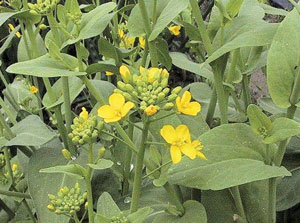Sarshap (Brassica campestris)
Sarshap is commonly known as sarason in Hindi and mustard/ English field mustard in English. It belongs to the family Cruciferae or Kandughna Gana in Ayurveda. The plant is a very important seed-oil crop in India.The genus Brassica is native to Western Europe, the Mediterranean and temperate regions of Asia but now a world-wide cultivated plant or weed of cultivation. It is grown here and there in the West African Region.The leaf is eaten in many countries, though it may be reserved sometimes as an emergency food in time of shortage. It is often fed to cattle also.
Plant description: An annual herb to 1 m or more high, root tuberous or fusiform, stem erect, stout, simple of branched, 30-100 cm high, leaves alternate, petioled, large, more or less pinnatifid, raceme or corymb. Flowers yellow, pedicellate, tetramerous, siliquas 3.7-7.5 cm, glabrous. Seeds small, pale or dark, smooth.
Ayurvedic pharmacology: Guna-tikshna, Ruksha- leaves, Snigdha-seed and oil, Rasa-katu, Tikta Vipaka-katu, Virya-ushna
Chemical composition: Flowers contain flavonol glycoside brassicoside. Seeds contain epi-progoitrin- major thioglucoside. The oil is one of the chief sources of erucic acid, a fatty acid of the oleic acid series and which has important applications in food and industry.
Therapeutically useful parts: Seed, oil.
Precaution: Leaves are often fed to cattle, but under certain circumstances it may be toxic due to the presence of the glycoside sinigrin which hydrolyses to a highly irritant volatile mustard oil though this property is also used in India for treating skin disease and snake bite.
Therapeutic uses: Seed paste and oil is applied in various skin diseases. Massage with the oil is beneficial in muscle pain. Daily massage with mustard oil is good for muscle strength. Mustard oil and salt are applied to treat pyorrhoea and other gum diseases. Powder of seeds is used internally to treat loss of appetite, to expel worms and to treat splenomegaly.
Doses: Seed powder, 2-4 grams.
Dr. Pratibha Mamgain,
Department of Ayurvedic Medicine

